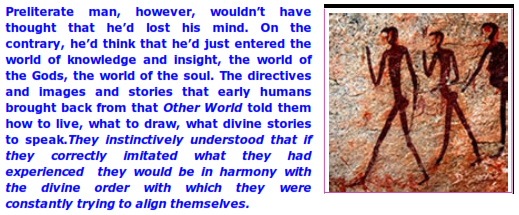1. THE SPIRITUAL NATURE OF PRELITERATE EGYPT.



Jaynes goes on to say that those directive voices also took the form of the voice of the Muse and were the origin of oral poetry, the dominant art of all preliterate cultures. I would add to that by saying that similar nonverbal visions were the origin of their visual art as well as their music and dance. That is why in Greece, for example, the very earliest reference to the Muse was plural: the Muses.

Today, when we speak of spirituality:
1) If we’re religious, we mean consciously following the precepts and practices of a given religion (meditating, saying prayers, becoming a missionary, saying the rosary, Love thy neighbor, don’t eat pork, confess your sins, travel to Mecca, don’t eat meat on Friday, observe the Sabbath etc.)
OR
2) if we’re not religious, we mean consciously practicing such things as meditation, Sufi dancing, OM breathing etc., all of which are very old practices aimed at stopping the busy chatter of our modern, self-obsessed consciousness so as to bring us to a state of inner peace.
These forms of modern spirituality, however, are all conscious practices, consciously initiated and acted out by us. Those kinds of conscious spirituality are radically different from the spirituality of preliterate humans, which issued from the unconscious and was primarily psychic in nature.
Theirs was a spirituality that was either initiated entirely by the unconscious (visions, voices) or was the result of consciously initiated practices that allowed them to leave their ordinary consciousness and enter the realm of the unconscious mind. (Today, we call such practices lucid dreaming, astral voyages, remote viewing, telepathy, etc.). No one knows what those consciously-initiated practices were in preliterate cultures, or their extent and sophistication, but I believe they must have been far greater than the remnants used today by those among us having psychic abilities.

Preliterate man experienced his powerful unconscious as the Other World, the world of voices and visions and Gods. Because of that, the spiritual objective of preliterate humans was to experience that Other World and then imitate it in their art and actions.
Imitating what they experienced was their way of acknowledging that they understood the intent of the Gods and were aligning themselves with it in order to establish harmony between the themselves and the heavens. This is something that theorists seem to be unaware of to a large degree, seeing the spiritual activities of preliterate peoples as consisting mostly of placating the unpredictable Gods. This placating was always present to some degree, but the establishment of a human / divine harmony was always foremost in their minds. I believe this was especially true of the ProtoÉgyptians because we can see their alignment practices blossom much later in Dynastic Egypt in such monumental efforts as the Giza pyramid complex, which is clearly an attempt to achieve harmony with the heavens by imitating it in the Giza complex, something gone into in great detail by Robert Bauval (The Orion Mystery) .
















